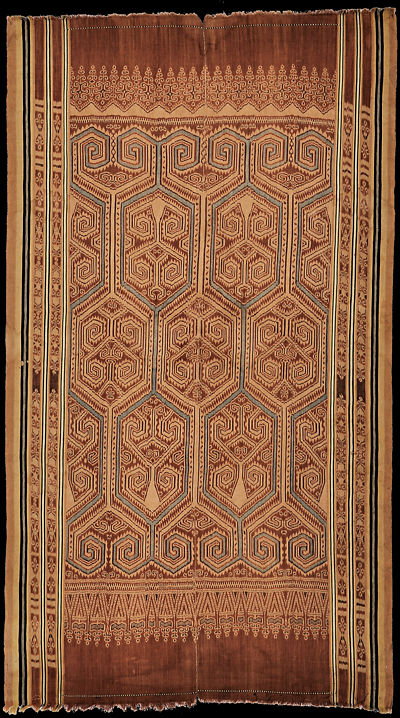| |
368 Borneo, Sarawak
Pua kumbu (blanket)  
|
| Locale: | Saratok, or Paku river, one of the two main tributaries of the Betong in the heart of the Saribas region. |
| Period: | Early 20th c. |
| Yarn: | Cotton, hand-spun, fine, twin warp, triple weft |
| Technique: | Warp ikat |
| Panels: | 2 |
| Size: | 107 x 201 cm (3' 6" x 6' 7") LW: 1.88 |
| Weight: | 610 g (21.5 oz), 284 g/m2 (0.93 oz/ft2) |
| Design: | Vernon Kedit: 'This ubiquitous design goes by many names in the Saribas, depending on the river and the weaver's family's weaving tradition but the most generic name would be Tangga Remang or Ladder of Clouds. The Western mind would understand better if I said Chariots of the Gods. As for the origin, on first glance, it screams Saratok. But take a second look at the fine edge motifs. They scream Paku.' |
| Comment: | The fine hand-spun yarn, which has yielded a light-weight cloth, supports early dating. Vernon Kedit: 'Saratok is near Betong. Classified linguistically as part of the Saribas region as many Betong Iban migrated to Saratok in the 19th century and maintained Saribas culture and customs with some variations on the weaving traditions.' (FB comment to Perry Kesner post 12-11-2021). The weave is not the common twin warp with twin weft, but twin warp with triple weft - rare in both Sawarak and Kalimantan, but also seen in Saribas pua PC 369. Ex-collection Wilhelm Berns. |
| Background: | Chapters on Borneo and Sarawak. |
| Compare: | 369 |
| Sources: | Very similar to pua in Rijksmuseum, Amsterdam, AK-MAK-1742-19, dated 1900-1949, but with finer detailing. Saratok origin identified by Vernon Kedit. The way the weaver used the replications of the basic ikated motif, with two of the bands mirrored along their vertical axis, were explicated for the FB Ethnic Textiles Community by John Cheah. See image below.
 |
| |

©Peter ten Hoopen, 2025
All rights reserved.
|


